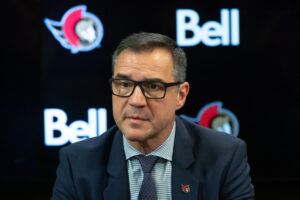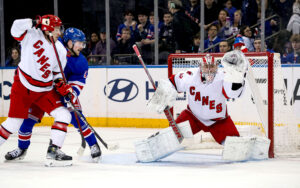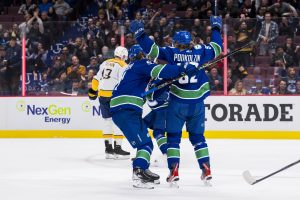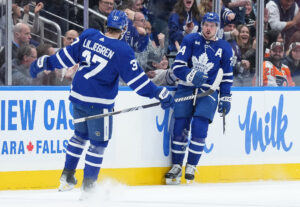NHL What-If is a series that looks at big moments in NHL history and wonders what might have happened had things played out slightly differently. The series is a focus on moments that impacted major games and franchises. The final moment to be examined is the Eric Lindros trade.
NHL What If… Eric Lindros Trade
History
In 1991 the Quebec Nordiques held the number one overall pick for the third year in a row. Quebec had iced some competitive teams since joining the NHL in 1979. While they could never achieve much playoff success, the Nordiques iced some entertaining teams. Unfortunately, in the late ’80s, the Nordiques fell on some hard times. Between 1988-89 to 1991-92 the Nordiques won a total of 75 games. An average of 18 per season. While it was dark days in Quebec City, there was a light at the end of the tunnel in the 1991 NHL draft.
Eric Lindros the Prospect
Eric Lindros was the consensus number one prospect in hockey. He was a rare breed of athlete. He physically dominated during his minor career often bossing older players around on the ice. Not just a physical specimen, Lindros also had tremendous stickhandling ability and could score with ease. He was originally selected by the Sault-Sainte Marie Greyhounds but refused to play for them. He was traded to the Oshawa Generals, where he could dominate the OHL. In 157 games played (including playoffs and Memorial Cup play), he would score 180 goals, 200 assist for 380 points and rack up 437 minutes in penalties.
In 1990-91 Lindros would win the OHL top scorer, MVP, the CHL top player of the year and top draft prospect awards. The Generals would win the Memorial Cup in 1990 also. The expectations on Lindros were so high, he was dubbed “The Next One”, in reference to Wayne Gretzky‘s “The Great One”.
The stage was set for Quebec to add Lindros to their prospect pool. A pool that already consisted of Mats Sundin, Owen Nolan, Joe Sakic, Valeri Kamensky, and Adam Foote. The Nordiques seemed on the cusp of something special with Lindros on his way. Unfortunately, Lindros had other plans.
What Really Happened
Leading up to the 1991 NHL draft, Eric Lindros and his camp made it clear they did not want to play in Quebec. He warned that if selected, he would hold out and refuse to play. As Quebec was a mainly francophone city (and province), Lindros felt, publically, his endorsement opportunities would suffer. Privately, Lindros also had an issue with the Nordique management and the stability of the Quebec franchise.
While Lindros made this kind of power play before in junior, it was reminiscent of the 1983 NFL draft. Top pick John Elway stated he would not play for the Baltimore Colts if selected. They picked him anyway and had to deal with the fallout.
Despite the warnings, the Nordiques, like the Colts, selected Lindros first overall. When selected, he refused to put on the team jersey and hat. In hopes of facilitating a move, Eric Lindros requested a $3M annual salary. Quebec was willing to meet hits demands, however. Rather than join the NHL team, Lindros elected to go back to Oshawa and play his final year of junior. He also competed for Canada in the 1992 winter Olympics. While contract negotiation went on throughout the 1991-92 season, no resolution could be found. In 1992, the Nordiques announced they were going to move on from Lindros and were fielding trade offers.
Trade Offers for Eric Lindros
Immediately teams were submitting their best offers. Quebec has trade discussions with the Toronto Maple Leafs, Calgary Flames, New Jersey Devils, Philadelphia Flyers, New York Rangers and Detroit Red Wings.
Detroit emerged as an early front runner. They were rumored to have offered Steve Yzerman, Steve Chiasson and draft picks to Quebec. Yzerman also balked at playing for Quebec, however, and the negotiations fell apart. The Flames were reported to have offered goalie Mike Vernon and two of their top five players – Gary Roberts, Theoren Fleury, Joe Nieuwendyk, Gary Suter or Al MacInnis. Toronto reportedly offered Daniel Marois, Yanic Perreault, several first-round picks and $20M in cash. There was even a rumor that the Montreal Canadiens were also involved in trade talks for the Big E. Apparently, the Habs offered up a package that included Patrick Roy in an attempt to land Lindros.
Trade Controversy
Teams were eager to acquire the potentially franchise-altering prospect. Some of the rumored offers would be questioned as being too high, then Flyers GM Russ Farwell said, “If you could have traded for Gretzky at 19 years old, what should the price be, or what would you pay?”.
By late June two teams emerged as serious contenders for Lindros; the Rangers and Flyers. The Rangers were rumored to have a package that included Tony Amonte, Sergei Nemchinov, Alex Kovalev, James Patrick, either John Vanbiesbrouck or Mike Richter, multiple first-round picks and $20M in cash. The names coming out of Philadelphia were Mike Ricci, Rod Brind’Amour, Mark Recchi, Steve Duchesne, Ron Hextall, Dominic Roussel, multiple first-round picks and $15M in cash.
On June 20th, the Nordiques had reached a verbal agreement with the Flyers, contingent that Lindros would accept a trade to Philadelphia. Quebec allowed the Flyers to contact Lindros to discuss terms and if he wanted to play with the Flyers. While the trade to the Flyers was being finalized, but not official, the Nordiques then accepted a trade from the Rangers. The Flyers filed an appeal with the league, stating the Nordiques reneged on their agreed-upon deal. The NHL appointed an arbitrator to settle the issue. After a five day hearing and a total of 10 days after the trades, the arbitrator gave his verdict. Eric Lindros was going to the Flyers.
In the end, the Flyers sent Ricci, Duchesne, Hextall, Peter Forsberg, Kerry Huffman, Chris Simon and 1993 and 1994 first-round picks to get Lindros.
Aftermath
Flyers
With the Flyers, Lindros lived up to his billing. He was one of the most dominant power forwards in the history of the game. In eight seasons with the Flyers, Lindros amassed 290 goals, 569 points and 946 penalty minutes. In 1995 he won the Hart and Lester B. Pearson awards. Unfortunately, the Flyers were never able to win a Cup during this time, despite being one of the top teams in the league. The relationship between Lindros and the Flyers would deteriorate, however. Several issues, including issues with the Flyers training staff, led to heated public exchanges between Lindros’ camp and Flyers GM Bobby Clarke. During the 2000 season, Lindros would publicly criticize the Flerys training staff for failing to properly diagnose a concussion in March and letting him play for two weeks before getting it right. Clarke responded by stripping Lindros of his captaincy.
Lindros suffered another concussion rehabbing. He returned to the Flyers lineup for game six of the Eastern Conference Final against the Devils. During Game 7, Lindros received another concussion after a Scott Stevens hit. Lindros would sit out the entire 2000-01 season in a contract dispute. He would be traded to the Rangers for the 2001-02 season. He would play three seasons with the Rangers and parts of two more seasons with Toronto and the Dallas Stars before retiring in 2007.
Lindros’ career is a giant what if. Despite his injuries, he was still able to have a successful career that landed him in the hockey hall of fame. Unfortunately, he is most remembered for his concussion issues and public feuds than his play on the ice.
Nordiques/Avalanche
The Nordiques would turn around in the 1992-93 season. The Nordiques young talent began to mature and Quebec began to look like a real threat. In the 1994-95 season, the Nordiques were the best team in the Eastern Conference. Unfortunately, some of the ownership issues Eric Lindros was worried about were realized. The Nordiques would relocate to Colorado for the 1995-96 season.
The trade worked out very well for Quebec/Colorado. Initially, Hextall gave the team solid goaltending the helped them back to the playoffs in 1993. He didn’t stay long in Quebec however. Mike Ricci and Chris Simon were key role players for Quebec/Colorado as well. Still, the centerpiece of the trade was Forsberg. The Swede would play a key role in two Colorado Stanley Cup victories and landed in the hockey hall of fame.
Rangers
The Rangers keep their organizational depth that plays a key role in their Stanley Cup win in 1994. The win ends a 54-year drought for the Blueshirts. While missing out on Eric Lindros definitely stung, the Rangers were actually a bit fortunate they lost out.
What If…
The Rangers are awarded Eric Lindros by the arbitrator. The final trade that was agreed upon was Doug Weight, Amonte, Patrick, Kovalev, Nemchinov, and Vanbiesbrouck, three first-round picks and $20M in cash. Eric Lindros is now on broadway. It’s an interesting trade for sure. Quebec gets way more depth, while the Rangers get the best player in the deal.
No More ’94
Still, the trade does mean the Rangers don’t win the 1994 Stanley Cup. Many of the key supporting players of that run are no longer with the team. Kovalev was third in playoff scoring for the Rangers in ’94. The Rangers don’t acquire Brian Noonan and Stephane Matteau from the Chicago Blackhawks because Amonte is already in Quebec.
The Rangers also can’t acquire Esa Tikkanen as Weight is also not available to trade anymore. James Patrick can’t be part of a package to Hartford to acquire Steve Larmer and Nick Kypreos. There is no Messier guarantee, there is no “Matteau! Matteau! Matteau!” call and the curse is not broken.
New York Rangers
It’s all bad for the Blueshirts. Lindros and Messier are the best centre combination in the NHL. The Rangers are a perennial playoff team, but their overall lack of depth continues to hold the team back. The Rangers struggle to find ways to surround Eric Lindros with the talent to push them over the top.
Lindros plays his entire career in New York and never suffers from the injury and concussion issues that befell him in Philadelphia. Staying healthy lets Lindros retire with a career point total in the top five. While the ultimate prize still eludes him (and the Rangers) Lindros is remembered for his stellar on-ice play rather than a cautionary tale of dangers of concussions.
Quebec
None of the players that come to Quebec are on the level of Peter Forsberg. Still, the influx of players makes Quebec one of the deepest teams in the NHL. Amonte, Weight, Kovalev, Nemchinov, and Patrick join a team that already has Joe Sakic, Mats Sundin, Owen Nolan, Valerie Kamensky Scott Young, Alexei Gusarov and Adam Foote. It’s a deep young core that will lead Quebec for years to come.
By 1994-95 Quebec is the best team in the East but does not fall in the opening round of the playoffs (to the Rangers). Rather they meet in the Eastern Conference Final. Quebec bests the Rangers in six games and faces the Red Wings in the Stanley Cup. The upstart Nordiques are not quite ready for prime time however and the Red Wings take the Cup in six games.
Unfortunately, the run to the Stanley Cup is not enough to keep the Nordiques in Quebec. While fan support is there, it does not change the weak Canadian dollar and overall financial issues of the team.
Colorado
Colorado inherits a team on the cusp of greatness. However, with Vanbiesbrouck in nets, the Avs have no need for Patrick Roy, so he is traded elsewhere. Also, the Florida Panthers never get a chance to pick the Beezer in the 1993 expansion draft. Florida never makes their run to the 1996 Cup finals.
The Colorado/Detroit rivalry dominates the Western Conference for the next several years. The teams dominate the NHL. They win a combined seven Cups between 1995 and 2002. Both teams are so loaded with talent and depth it’s difficult for other teams to match up.
Flyers
Philadelphia keeps Forsberg, arguably the best player in the original deal. He maintains his hall of fame career with the Flyers. Philadelphia becomes a strong team on the cusp of breaking out. Still, without Lindros, the Flyers aren’t as eager to part ways with Mark Recchi. The Flyers never make the trade for Eric Desjardins, John LeClair, and Gilbert Dionne. Without Lindros or LeClair, the Legion of Doom line never forms. Never the less, the Flyers are still a gritty team with a great first line. They are perennial playoff participants. Still, the Flyers can’t get over the hump in the East. While they compile some great teams, the same old issues arise. Goaltending.






